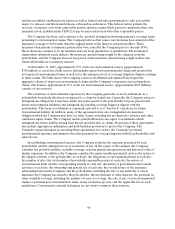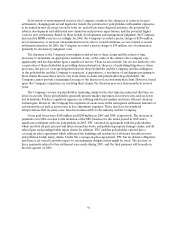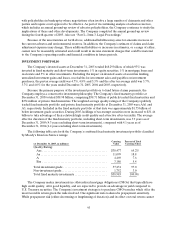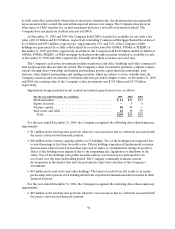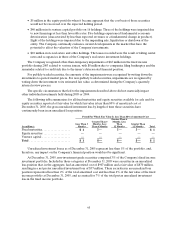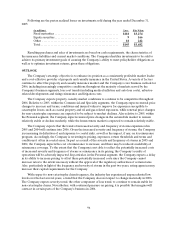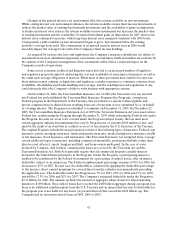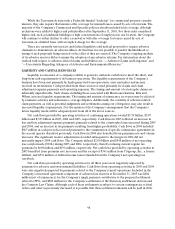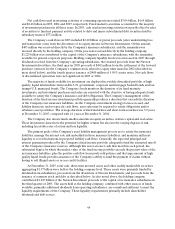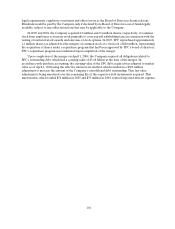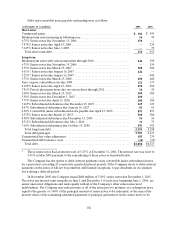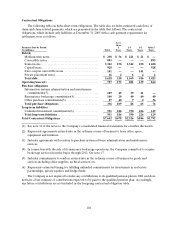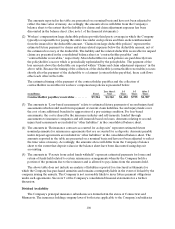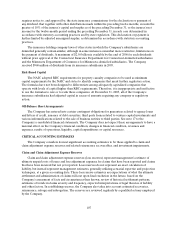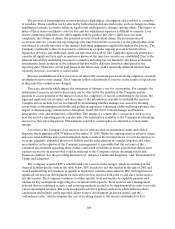Travelers 2005 Annual Report Download - page 110
Download and view the complete annual report
Please find page 110 of the 2005 Travelers annual report below. You can navigate through the pages in the report by either clicking on the pages listed below, or by using the keyword search tool below to find specific information within the annual report.98
While the Terrorism Acts provide a Federally-funded “backstop” for commercial property casualty
insurers, they also require that insurers offer coverage for insured losses caused by acts of terrorism. The
majority of the Company’s Commercial and Specialty policies already included such coverage, although
exclusionswere added to higher-risk policyholders after September 11, 2001. For those risks considered
higher-risk, such as landmark buildings or high concentrations of employees in one location, the Company
will continue to either decline to offer a renewal or will offer coverage for losses caused by acts of
terrorism on a limited basis, with an explicit charge for the coverage.
There are currently various state and federal legislative and judicial proposals to require asbestos
claimants to demonstrate an asbestos illness. At this time it is not possible to predict the likelihood or
timing of such proposals being enacted or the effect if they are enacted. The Company’s ongoing analysis
of its asbestos reserves did not assume the adoption of any asbestos reforms. For information about the
outlook with respect to asbestos-related claims and liabilities see “—Asbestos Claims and Litigation” and
“—Uncertainty Regarding Adequacy of Asbestos and Environmental Reserves.”
LIQUIDITY AND CAPITAL RESOURCES
Liquidity is a measure of a company’s ability to generate sufficient cash flows to meet the short- and
long-term cash requirements of its business operations. The liquidity requirements of the Company’s
business have been met primarily by funds generated from operations, asset maturities and income
received on investments. Cash provided from these sources is used primarily for claims and claim
adjustment expense payments and operating expenses. The timing and amount of catastrophe claims are
inherently unpredictable. Such claims, including those associated with Hurricanes Katrina,Rita and
Wilma, increase liquidity requirements. The timing and amount of reinsurance recoveries may be affected
by reinsurer solvency and reinsurance coverage disputes. Additionally, the volatility of asbestos-related
claim payments, as well as potential judgments and settlements arising out of litigation, may also result in
increased liquidity requirements. It is the opinion of the Company’s management that the Company’s
future liquidity needs will be adequately met from all of the above sources.
Net cash flows provided by operating activities of continuing operations totaled$3.59 billion, $5.07
billion and $3.83 billion in 2005, 2004 and 2003, respectively. Cash flows in 2005 reflected an increase in
loss and loss adjustment expense payments primarily related to the catastrophe losses incurred during 2005
and 2004, and an increase in tax payments resulting from higher profitability. Cash flows in 2004 included
$867 million in cash proceeds received pursuant to the commutation of specific reinsurance agreements in
the second quarter described previously. Cash flows in 2004 also benefited from premium rate and volume
increases. The significant reserve adjustments recorded subsequent to the merger in 2004 did not
materially impact 2004 cash flows. The Company utilized $2.00 billion and $548 million of net operating
loss carryforwards (NOL) during 2005 and 2004, respectively, thereby reducing current regular tax
payments by $698 million and $192 million, respectively. Net cash flows provided by operating activities in
2003 benefited from premium rate increases and the receipt of $361 million from Citigroup, Inc., a former
affiliate, and $531million of federal income taxes refunded from the Company’s net operating loss
carryback.
Net cash flows provided by operating activities for all three years were negatively impacted by
payments for asbestos and environmental liabilities. Cash flows from operating activities in 2005 and 2004
were also negatively impacted by payments related to the Company’s runoff operations. Included in the
Company’s structured agreement component of asbestos loss reserves at December 31, 2005 was $404
million (net of reinsurance) for the Company’s single payment contribution to the proposed settlement
related to PPG, and $502 million for the Company’s settlement of the Statutory and Hawaii Actions and
the Common Law Claims. Although each of these settlements is subject to certain contingencies or final
orders and relief as previously discussed, it is possible that these settlement amounts will be paid in 2006.




